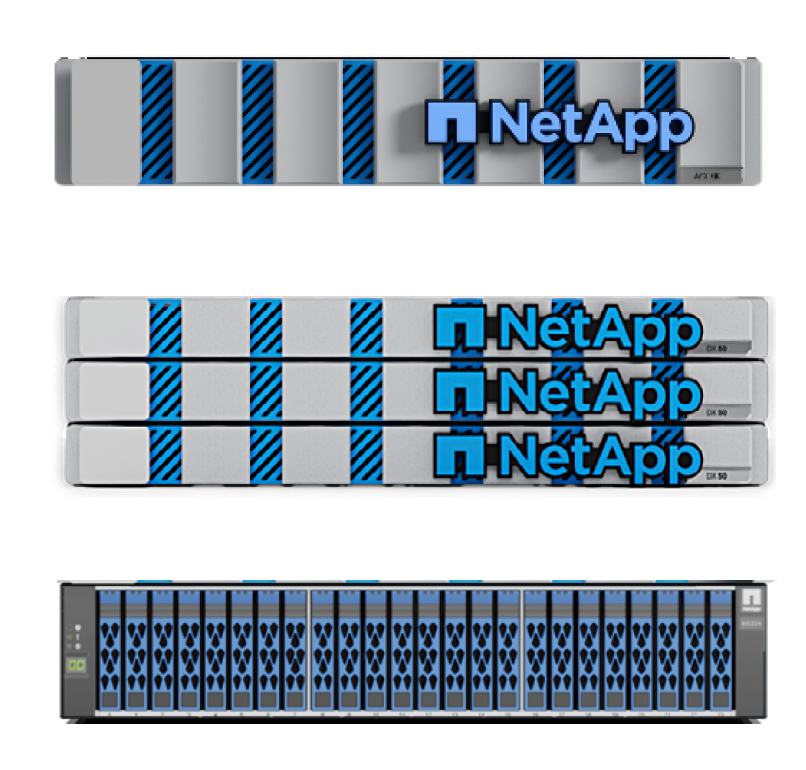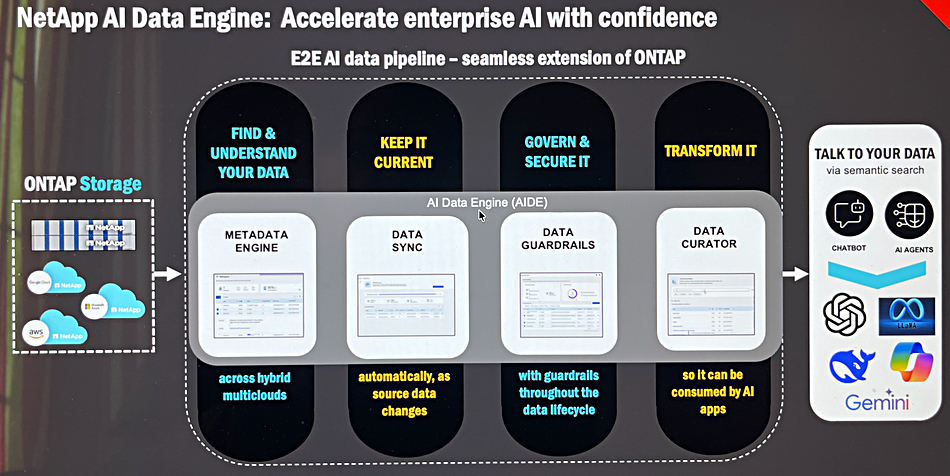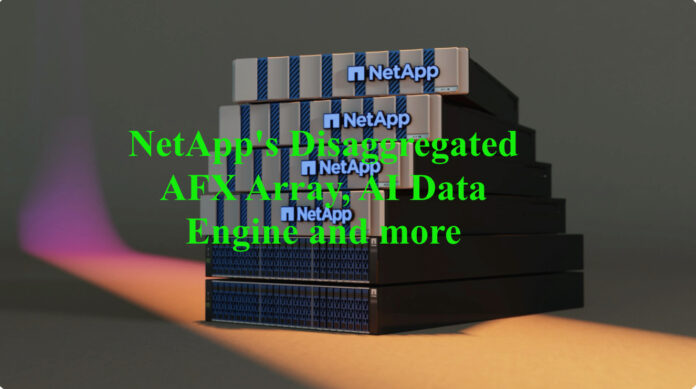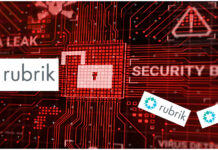New all-flash NetApp AFX arrays separately scale storage and compute while an AI Data Engine pre-processes ONTAP data for AI LLM and agent use, and customers get a NetApp Ransomware Resilience Service along with block-enhanced Goggle Cloud integration.
These announcements were made at NetApp’s INSIGHT 2025 event in Las Vegas, and represent its adoption of improved scale-out facilities and data pipeline capabilities for its storage in order to better support AI enterprise workloads, as well as strengthen its cyber-resilience facilities. The disaggregation of compute and storage nodes has been a distinguishing feature of VAST Data’s storage, enabling parallel access to data without using a complex parallel file system. The basic scheme has been taken up by HPE with its Alletra MP storage systems, Pure Storage with its FlashBlade//EXA and Qumulo with its Stratus software. Now NetApp is offering its AFX disaggregated storage to its 22,000 or so customers.

Netapp Chief Product Officer Syam Nair said: “The combination of NetApp AFX with AI Data Engine provides the enterprise resilience and performance built and proven over decades by NetApp ONTAP, now in a disaggregated storage architecture, and all still built on the most secure storage on the planet.”
AFX
The AFX arrays have three hardware components connected by a high-speed and low-latency internal network;

- AFX 1K storage controller: 2 RU enclosure with 11 PCIe gen 5 expansion slots running an ONTAP instance.
- Optional DX50 data compute node: AMD Genoa 9554P processor, Nvidia L4 GPU, 1 RU chassis. This powers the AFX metadata engine, and other AI Data Engine services. It continuously indexes data and enables data engineers to discover and curate datasets by using familiar SQL queries. As this engine runs on dedicated compute nodes, it doesn’t affect the performance of the primary AI workloads.
- NX224 NVMe enclosure (storage node): 24-slot NVMe SSD boxes supporting 7.6 TB, 15.3 TB, 30.7 TB, and 60TB SSDs and providing a single pool of storage.
There can be up to 128 AFX storage controllers in a cluster, along with up to 52 storage enclosures, which provide more than 1 EB of effective capacity, and 10 data compute nodes. The supported storage protocols are pNFS, NFS, SMB, S3, and NFS/RDMA. The internal Ethernet networking is based around Cisco Nexus 400G switches.

The AFX system requires ONTAP v9.17.1 or later and the AFX software includes the AI-powered, autonomous ransomware protection. It’s certified for NVIDIA DGX SuperPOD, and can connect to GPU servers using Cisco switches, with up to 64 fixed 400G ports on the Nexus 9364D-GX2A and 32 fixed 400G ports on the Nexus 9332D-GX2B.
It inherits ONTAP software features such as S3 SnapMirror data copying to StorageGRID, CloudSync and XCP connectivity to AWS, Azure and GCP, plus integration with NetApp’s AFF and FAS arrays via SnapMirror, SVM DR, SVM Migrate and FlexCache.
AI Data Engine
The AI Data Engine (AIDE) provides an AI data pipeline to have AFX-stored data made deliverable to and usable by AI Large language Models (LLMs) and agents. It is a built-in ASI-focussed ETL (Extract, Transform and Load) pipeline that uses the AFX metadata engine. The AIDE software can discover and characterize data spread across a customer’s NetApp data estate, both on-premises and in the three main public clouds. As fresh data comes in and/or old data is deleted the metadata is updated.

The metadata is used to govern the data and provide guardrails to protect its access and use, and AIDE also transforms – vectorizes – the data for LLM/agent use. Knowledge graph technology is being evaluated so that structured database records (block data) can also be used by the AI agents. There are four AIDE components covering these functions;
- Metadata engine – automatically generates a structured, up-to-date, interactive view of a NetApp data estate, with lightweight, optimized ASPs for querying
- Data Sync – maintains data recency automatically with SnapMirror for automated sync and SnapDiff for automatic change detection. Works across a global data estate.
- Data Guardrails – continually scans, classifies and categorizes data across hybrid multi-cloud environments. Identifies sensitive data and risks and facilitates policy creation for automated sensitive data handling. Sensitive data can be automatically redacted or excluded.
- Data Curator – data discovery, search, vectorization, and retrieval.
AIDE contains a vector database so that the unstructured data it manages can be used by LLMs and agents in semantic searches.
The AIDE system uses the Nvidia AI Data Platform reference design, which includes Nvidia GPUs, AI Enterprise software including NIM microservices for vectorization and retrieval, which joins advanced compression, fast semantic discovery, and secure, policy-driven workflows. AIDE will run natively within the AFX cluster on top of the optional DX50 data control nodes. Future ecosystem support includes the integration of Nvidia’s RTX PRO Servers featuring RTX PRO 6000 Blackwell Server Edition GPUs.
The subscription-based NetApp Keystone STaaS (Storage-as-a-Service) for Enterprise AI is based around AFX, the AIDE software, and built-in cyber-resilience. Its performance and capacity scale independently on demand. NetApp says it features pay-as-you-go pricing and predictable billing.
Ransomware resilience
NetApp’s Ransomware Resilience, previously called Ransomware Protection, is an integrated AI-powered ransomware detection facility. There are two new capabilities: data breach detection at storage level, which is a claimed first, and isolated recovery environments – clean rooms – to enable safe and clean recovery of mission-critical data.
The data breach detection is AI-driven and identifies anomalous user and file system behaviors that are early indicators of potential data exfiltration; a breach attempt. When a breach attempt is detected, Ransomware Resilience automatically alerts the customer via their security information and event management (SIEM) setup. Customers can also block further unauthorized transfer of sensitive data.
The isolated recovery environment uses AI-powered scanning to identify corrupted data and the point at which it was modified. It then guides the user through a workload restoration process of the most recent safe data.
NetApp says its ONTAP Autonomous Ransomware Protection with Artificial Intelligence (ARP/AI) now supports data stored in file and block protocols. It has demonstrated 99 percent detection of tested, full-file encryption ransomware attacks with zero false positives in external testing and validation.
Google Cloud
NetApp is improving and extending the integration of ONTAP services into its Google Cloud NetApp Volumes (GCNV) offering. This is a fully-managed file service based on NetApp’s ONTAP operating system running on the Google Cloud Platform as a native GCP service. It supports NFS V3 and v4.1, and SMB, and provides snapshots, clones, replication, and cross-region backup.
Now it’s getting three enhancements;
- Block Capabilities: The Flex service level now supports unified storage with both NAS (NFS/SMB) and SAN (iSCSI block) protocols. This better enables customers to use Google Cloud for their enterprise business appls, such as hosting virtualized environments and managing databases.
- Gemini Enterprise Integration: Customers can use data stored in NetApp Volumes as a native source for AI Applications front-ended by Gemini Enterprise, Google’s platform for automating business workflows using its Gemini family of machine learning models. NetApp says customers can build bespoke AI agents without custom code or RAG pipelines, and with context-specific data from reputable, vetted sources, improving the quality and reliability of AI-generated outputs.
- Enhanced Unified Global Namespace: Enterprises can now extend their unified global data estate across cloud and on-premises environments into Google Cloud with new FlexCache capabilities in NetApp Volumes. Data stored in other ONTAP-based storage in customer data centers or across multiple clouds can be instantly made visible and writeable in a NetApp Volumes environment, but with data transferred granularly only when requested. This allows for a customer’s entire hybrid cloud data estate to be seamlessly accessed in Google Cloud. Customers can migrate data and snapshots effortlessly between environments using SnapMirror, supporting hybrid use cases such as cloud migration, disaster recovery, and workload balancing across environments.
NetApp’s Pravjit Tiwana, SVP and GM of Cloud Storage and Services, said: “Our customers will benefit from consistent low-latency performance, enhanced data management with features like snapshots and replication, and the operational simplicity of managing both file and block storage from the same NetApp Volumes service.”
Other INSIGHT 2025 news
NetApp made other announcements including new & expanded collaborations with Red Hat, Equinix, and Cisco, aiming for deeper integration across hybrid cloud, virtualization, and AI infrastructures.
NetApp is now running its development and testing engineering environments on Red Hat OpenShift Virtualization, enabling faster provisioning, reduced complexity, and greater agility. Red Hat has built an intelligent data infrastructure that leverages NetApp ONTAP technology to power its global IT and development operations, enabling faster software delivery and improved operational efficiency.
NetApp and Red Hat have introduced new systems that bring together Red Hat OpenShift Virtualization with Amazon FSx for NetApp ONTAP and Red Hat OpenShift Service on AWS (ROSA), as well as Google Cloud NetApp Volumes on OpenShift Dedicated on Google Cloud.
The Equinix news is about SAP customers currently running or planning to move to S/4HANA having a path to move to a hosted virtualized managed services environment running VCF and NetApp ONTAP to optimize cost, efficiency, and security.
The NetApp AFX will soon feature in a FlexPod AI offering, which includes Cisco UCS servers and Nexus data center switching.
NetApp has introduced an Object API for Seamless Access to Azure Data & AI Services. Customers can now access their Azure NetApp Files data through an Object REST API. They no longer need to move or copy file data into a separate object store to use it with Azure services. Instead, NFS and SMB datasets can be connected directly to Microsoft Fabric, Azure OpenAI, Azure Databricks, Azure Synapse, Azure AI Search, Azure Machine Learning, and more.
Availability
Google Cloud NetApp Volumes block capabilities are now generally available to customers upon request. The strengthened Gemini Enterprise Integration is available in preview on customer request. The Object API for Seamless Access to Azure Data & AI Services is also in public preview.
Learn about the full set of new capabilities in Google Cloud NetApp Volumes and other updates across the NetApp portfolio here.
Get a NetApp AFX datasheet here.








